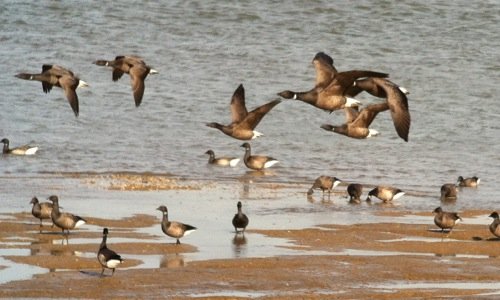I went along to the Swale yesterday — on the Kent side of the Thames estuary — on what turned out to be a startlingly warm day, for February. Bare arm weather! And very nice it was too, to have several hours of uninterrupted warm sunshine.
Spring was breaking out all over: loads of skylarks all over the place singing their hearts out, my first singing chiffchaff of the spring, my first butterfly of the year (a peacock), a great big bumblebee, and less appealingly, clouds of black midges.
But the overwintering seabirds were still there; big flocks of lapwing, curlew, golden plover, avocet, and most spectacularly, brent geese:
This is the kind of place that George Osborne was referring to in his Autumn Statement when he said “we will make sure that gold plating of EU rules on things like habitats aren’t placing ridiculous costs on British businesses”.
I can only assume the Treasury has a rule of thumb that, if conservation is actually working, it must mean we’re trying too hard.

It’s not just the wildlife itself which I think has value: it’s the fact that there is a place so near to London which actually feels a bit wild, a place where a person can feel small in Nature.
That wildness is a bit of an illusion; it’s a landscape gridded with seawalls, groynes and drainage ditches, all there to keep the sea and land decorously separate.

It must have been an amazing place in its truly natural state: a shifting, complex landscape of mudflats, saltmarsh, reedbeds, lakes, wet woodland, changing with the seasons and the tides. A wetland to compare with any in the world.
That landscape is lost forever. But at least we can try to hang on to what we have left. Not just as a refuge for the geese, so they can take a break from the Siberia tundra, but as a place where people like me can take a break from London.